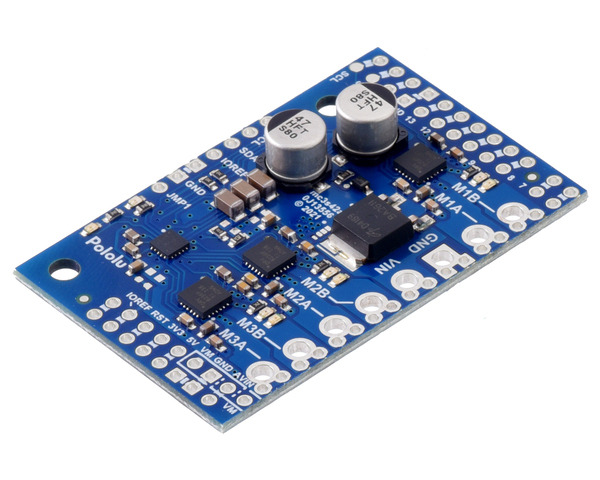

This is a merged information page for Item #5032.
View normal product page.
Pololu item #:
5032
Brand:
Pololu
Status:
Active and Preferred

The Motoron M3S256 Triple Motor Controller Shield for Arduino makes it easy to control DC motors from an Arduino or Arduino-compatible board through an I²C interface. Each module can independently control up to three motors, and multiple shields can be stacked on top of the same Arduino for projects that need to control even more motors. The M3S256 supports motor supply voltages from 4.5 V to 48 V and can deliver continuous output currents up to 2 A per motor. This version is just the motor controller by itself, without any header pins or terminal blocks included.
 Compare all products in Motoron M3S256 Triple Motor Controller Shield for Arduino.
Compare all products in Motoron M3S256 Triple Motor Controller Shield for Arduino.
 |
Motoron M3S256 Triple Motor Controller Shield for Arduino (No Connectors). |
|---|
 |
Motoron M3S256 Triple Motor Controller Shield for Arduino, top view. |
|---|
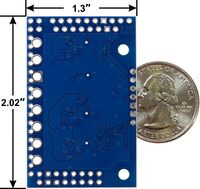 |
Motoron M3S256 Triple Motor Controller Shield for Arduino, bottom view with dimensions. |
|---|
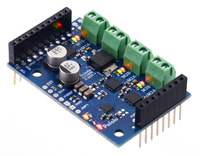 |
Motoron M3S256 Triple Motor Controller Shield for Arduino (Connectors Soldered). |
|---|
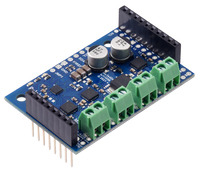 |
Motoron M3S256 Triple Motor Controller Shield for Arduino (Connectors Soldered). |
|---|
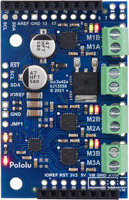 |
Motoron M3S256 Triple Motor Controller Shield for Arduino (Connectors Soldered), top view. |
|---|
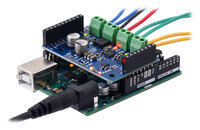 |
Motoron M3S256 shield being controlled by an Arduino Uno. |
|---|
 |
Three Motoron M3S256 shields being controlled by an Arduino Uno. |
|---|
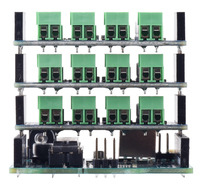 |
Three Motoron M3S256 or M3S550 shields attached to an Arduino Uno, showing the spacing of the 3.5 mm terminal blocks. |
|---|
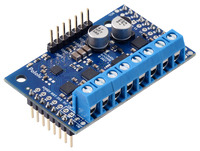 |
Motoron M3S256 Triple Motor Controller Shield Kit for Arduino, assembled with the larger (5mm-pitch) blue terminal blocks and male headers. |
|---|
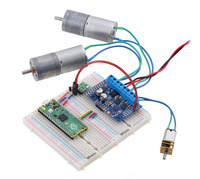 |
A Raspberry Pi Pico on a breadboard using a Motoron M3S256 shield to control three motors. |
|---|
 |
Using the Motoron M3S256 or M3S550 Triple Motor Controller Shield with an Arduino. |
|---|
 |
Motoron M3S256 or M3S550 Triple Motor Controller Shield pinout. |
|---|
The Motoron M3S256 shield makes it easy to control up to three bidirectional, brushed DC motors with an Arduino or compatible board, such as the A-Star 32U4 Prime. It supports motor supply voltages from 4.5 V to 48 V and can deliver continuous output currents up to 2 A per motor. Multiple Motoron controllers can be stacked on top of each other, allowing independent control of many motors. Unlike most of our motor drivers and motor driver shields, the Motoron does not require any PWM outputs or timers on your Arduino. Instead, the Arduino communicates with the Motoron using I²C, so only two I/O lines are needed regardless of how many Motorons you connect.
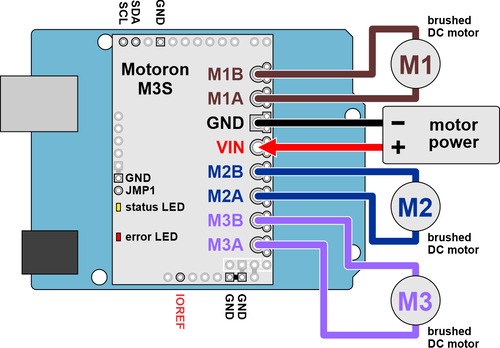 |
Three M3S256 versions are available to provide different options for the through-hole connectors:
For applications using a Raspberry Pi, consider the Motoron M3H256 instead (also available with different connector options).
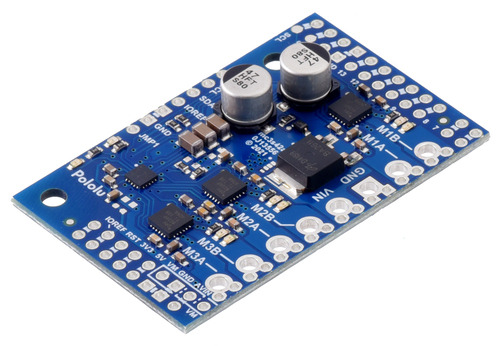 |
Motoron M3S256 Triple Motor Controller Shield for Arduino (No Connectors). |
|---|
This Motoron version is just the assembled PCB module as shown above, with no connectors included. This version is intended for those who mostly want to solder wires directly to the board or use different connectors from those included with other versions. We have a variety of connectors available separately.
|
|
 |
Motoron M3S256 or M3S550 Triple Motor Controller Shield pinout. |
|---|
The tables below list the members of the Motoron family and show the key differences among them. Each type is available in several versions to provide different options for the through-hole connectors: they can be purchased as an assembled product with connectors soldered in, as a kit with connectors included but not soldered in, or (for Arduino and Raspberry Pi expansions) as a standalone board without connectors.
| Motoron motor controllers micro versions |
||||
 M1T550  M1U550 |
 M2T550  M2U550 |
 M1T256  M1U256 |
 M2T256  M2U256 |
|
|---|---|---|---|---|
| Control interface: | I²C or UART serial | |||
| Motor channels: | 1 (single) | 2 (dual) | 1 (single) | 2 (dual) |
| Minimum motor supply voltage: |
1.8 V | 4.5 V | ||
| Absolute max motor supply voltage: |
22 V | 48 V | ||
| Recommended max nominal battery voltage: |
16 V | 36 V | ||
| Max continuous current per channel: |
1.8 A | 1.6 A | 2.2 A | 1.8 A |
| Logic voltage range: | 3.0 V to 4.9 V(1) | 3.0 V to 5.5 V | ||
| Current sensing/limiting: | – | – | – | – |
| Available versions with I²C: |
||||
| Available verions with UART serial: |
||||
| Price: | $14.24 – $16.19 | $18.67 – $20.69 | $19.71 – $21.72 | $28.72 – $30.73 |
| 1 The M1x550 and M2x550 are not recommended for use with 5V nominal logic. | ||||
| Motoron motor controllers Arduino and Raspberry Pi form factor versions |
||||||
 M3S550  M3H550 |
 M3S256  M3H256 |
 M2S24v14  M2H24v14 |
 M2S24v16  M2H24v16 |
 M2S18v18  M2H18v18 |
 M2S18v20  M2H18v20 |
|
|---|---|---|---|---|---|---|
| Control interface: | I²C | |||||
| Motor channels: | 3 (triple) | 2 (dual) | ||||
| Minimum motor supply voltage: |
1.8 V | 4.5 V | 6.5 V | |||
| Absolute max motor supply voltage: |
22 V | 48 V | 40 V | 30 V | ||
| Recommended max nominal battery voltage: |
16 V | 36 V | 28 V | 18 V | ||
| Max continuous current per channel: |
1.7 A | 2 A | 14 A | 16 A | 18 A | 20 A |
| Logic voltage range: | M3S550 3.1 V to 5.5 V |
3.0 V to 5.5 V | 3.0 V to 5.5 V | |||
| M3H550 3.0 V to 4.9 V(1) |
||||||
| Current sensing/limiting: | – | – | ||||
| Available versions for Arduino: |
M3S550 | M3S256 | M2S24v14 | M2S24v16 | M2S18v18 | M2S18v20 |
| Available versions for Raspberry Pi: |
M3H550 | M3H256 | M2H24v14 | M2H24v16 | M2H18v18 | M2H18v20 |
| Price: | $25.26 – $36.14 | $42.01 – $52.94 | $71.67 – $83.56 | $96.51 – $108.41 | $71.67 – $83.56 | $109.91 – $120.39 |
| 1 The M3H550 is not recommended for use with 5V nominal logic. | ||||||
| Size: | 1.3″ × 2.02″ |
|---|---|
| Weight: | 7.5 g |
| Channels: | 3 |
|---|---|
| Model: | Motoron M3S256 |
| Control interface: | I²C |
| Minimum operating voltage: | 4.5 V |
| Maximum operating voltage: | 48 V1 |
| Continuous output current per channel: | 2.0 A |
| Peak output current per channel: | 6.4 A |
| Minimum logic voltage: | 3.0 V |
| Maximum logic voltage: | 5.5 V |
| Reverse voltage protection?: | Y2 |
| Connectors soldered?: | N |
| PCB dev codes: | mc3s42a |
|---|---|
| Other PCB markings: | 0J13556 |
User’s manual for the Pololu Motoron Motor Controllers.
This DXF drawing shows the locations of all of the board’s holes.
No FAQs available.
We’re excited to announce the launch of our new Motoron M3S256 Triple Motor Controller Shield! This I²C motor controller is designed to plug into...